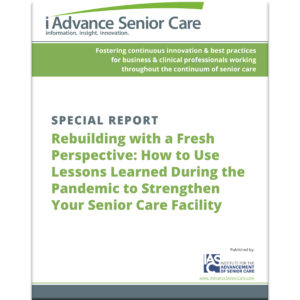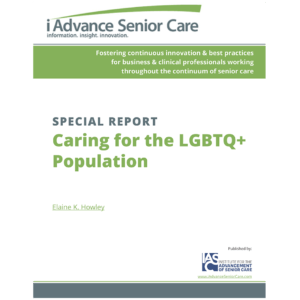COVID-19 Emergency Prep: Are You Ready for What’s Next?

Laura Hofmann, MSN, RN, director of clinical and nursing facility regulatory services, LeadingAge Washington
If the COVID-19 pandemic follows a pattern that is similar to other respiratory viruses, many infectious disease experts anticipate that the United States could see a nationwide surge in cases in the coming weeks and months.
While testing is an essential (and now required) component of risk mitigation for nursing homes, the following steps also can help directors of nursing services (DNSs) and other members of the management team develop a workable pandemic infection control plan that reduces the risk—and the impact—of future COVID-19 outbreaks:
Don’t Let Your Guard Down
“Just because you haven’t had COVID-19 in your building yet doesn’t mean you won’t have it the next time it sweeps through your community,” says Laura Hofmann, MSN, RN, director of clinical and nursing facility regulatory services for LeadingAge Washington in Tacoma, WA. “Similarly, just because you’ve had it once doesn’t mean you won’t be reinfected. Some facilities have already had second outbreaks even after successfully eradicating COVID-19 from the building.”
Tap Into the COVID-19 Information Flow
“COVID-19 guidance and education are being sourced through various offices at the Centers for Disease Control and Prevention (CDC), the Centers for Medicare & Medicaid Services (CMS), the state health department, and the National Health Safety Network (NHSN),” says Katrina Anderson, LVN, director of skilled nursing and part-time infection preventionist for the John C. Fremont Healthcare District in Mariposa, CA, as well as a member of the Disaster Preparedness Program Advisory Council at the California Association of Health Facilities (CAHF). “Someone needs to be reviewing these communications as they are released and participating in the webinars and teleconferences.”
Keep Staff Up to Date in Real Time
“An emergency preparedness plan without education and training is paper compliance,” says Hofmann. “When you update your plan, you can’t just update your protocols,” she points out. “For example, in the early days of the COVID-19 pandemic, managers at one facility regularly updated the pandemic infection control plan to incorporate the constant flow of changes coming from CMS and the CDC, but staff members were never educated on any of those changes. You need to move away from paper compliance by training your staff on the updated protocols, and making sure they know what your plan is.”
An information bottleneck is a common problem, agrees Anderson. “Often, the staff member who is in charge of the pandemic infection control plan doesn’t have a strong communication system for dispersing that information to the staff on a real-time basis. If the information comes out today, the education should go out today.”
While it’s important to provide brief written information, such as a daily training log, staff education also should go a step further, suggests Anderson. “You have to be out on the floor explaining, ‘This is what is going on, and this is why it has to be this way. These are the pros and cons.’ You should be engaged and take questions so that you can in turn engage staff.”
Train Staff with Dry Runs and Pop-Up Compliance Tests

Katrina Anderson, LVN, director of skilled nursing and part-time infection preventionist, John C. Fremont Healthcare District
Training is incomplete without drills, says Hofmann. “When you write an evacuation plan on paper, you ensure staff are trained on that plan by having an evacuation drill with room searches, resident triage, and fire department participation as indicated in your plan. If you haven’t yet had COVID-19 in your building, you should do a similar type of drill—a dry run—for your pandemic infection control plan.”
Once staff have been educated on the plan, providers need to see the plan in action, says Hofmann. “For example, following in the footsteps of one DNS I know, you can call the charge nurse on duty at 4 a.m. and say, ‘You’ve got a resident who is positive for COVID-19, and you can’t get in touch with me or the administrator. What do you do?’ By the time you get to work, the plan should be enacted and ready for review. Then for example, if your plan requires zip walls, you can see whether staff set up zip walls as required and whether those zip walls are properly installed (e.g., there are no air leaks around them). Whatever your plan includes, make sure that all staff members understand how to execute it properly.”
Drills are key, but not just big planned drills, adds Anderson. “Large drills tend to pull in administrators and nursing supervisors. Real-time pop-up drills are most effective for getting your everyday team on the floor prepared for what to do should one of those events happen. A pop-up drill can be as simple as standing in the middle of the hallway and saying, ‘I saw this resident start coughing. What do you do first? Where is the check sheet with the information you need? Who is in charge? How do you isolate?’ Go through all of the steps in your plan to make sure your staff know them and can implement them when needed.”
Providers also should routinely do spot-checks of hand hygiene and personal protective equipment (PPE) compliance even when there is no outbreak in the building, says Hofmann. “For example, walk up to staff and say, ‘You have COVID-19 in your building. Please demonstrate how you would appropriately don this PPE,’ so that you can see whether staff follow facility policy.”
Always Do After-Action Reports
“The after-action report is critical any time you have an actual emergency or do an exercise,” says Hofmann. You have to do a deep dive into what went well—and what didn’t—so you can see what you need to adjust and where you need to retrain staff.”
Double-Check Your Infection-Control Risk Assessment
Due to the COVID-19 public health emergency, the most recent risk assessment for infection control conducted by many nursing homes usually addresses respiratory infections, says Hofmann. “However, you should re-do your risk assessment to take a critical look at what other infections may occur in your community. You don’t want to be so focused on COVID-19 and other respiratory infections that you overlook, for example, a Clostridioides difficile (C. diff), Methicillin-resistant Staphylococcus aureus (MRSA), or norovirus outbreak in your county.”
The symptoms of some common infections that often occur in the fall and winter overlap with COVID-19 symptoms, adds Hofmann. “For example, diarrhea can be a symptom of both norovirus and COVID-19, while influenza and COVID-19 often share similar respiratory symptoms,” she explains. “Consequently, you will need a plan to closely monitor your building with an infection control eye and then to determine what infection you are actually dealing with.”
Note: Learn more about addressing both COVID-19 and influenza in this Washington Society for Postacute and Long-Term Care prerecorded webinar, COVID-19 and Influenza “Twindemic.”
Track PPE Use
Reviewing the facility’s pandemic infection control plan should include a deep-dive into the PPE supply, says Hofmann. “If you haven’t been using the CDC’s PPE Burn Rate Calculator, you should start now so that you can understand what your average consumption is and project how long you can expect your PPE supply to last.”
In a perfect world, nursing homes that currently don’t have a COVID-19 outbreak would be able to stockpile PPE, says Hofmann. “However, shortages are continuing for most PPE. For example, many facilities now have to get washable gowns because the disposable gowns simply aren’t available. If you’re using the calculator, at least supply shortages won’t catch you by surprise, and you can more effectively plan contacts with alternative suppliers, your local healthcare coalition, or your state health department when needed.”
Note: Providers should report supplies of less than one week via the Supplies and Personal Protective Equipment pathway in the NHSN Long-Term Care Facility (LTCF) COVID-19 Module.
It’s also important to assess PPE utilization in the context of the recommendations for universal PPE use in the CDC guidelines, Interim Infection Prevention and Control Recommendations for Healthcare Personnel During COVID-19 Pandemic, says Hofmann. “For example, the CDC guidelines recommend universal eye protection for all staff when there is moderate to substantial community transmission, as well as eye protection based on anticipated exposures and suspected/confirmed diagnoses when there is minimal to no community transmission. Some facilities ignore universal eye protection guidelines when suppliers can’t provide enough goggles and face shields. However, even to meet the requirements for contingency or crisis capacity PPE optimization strategies, you have to understand your utilization rate and make the effort to find adequate supplies of the appropriate PPE. Otherwise, you run the risk for a citation in a COVID-19 Focused Survey.”
Providers also need to be careful about working with new PPE suppliers, says Hofmann. “For example, some facilities tried to source PPE through a beauty supply, and they ended up purchasing PPE that was not intended for medical use.”
Note: Learn how to identify gowns and surgical masks cleared by the Food and Drug Administration here and how to select respirators here and here (slide 23).
Look at COVID-19 as Culture Change
One option is not to do any performance improvement projects (PIPs) on COVID-19, points out Anderson. “Basically, a PIP focus would involve rewriting how you run your facility, and managing a project that large could take more time than three people have. Therefore, you could benefit from approaching COVID-19 as a complete culture change—the new normal—in the building while still doing all of the surveillance and monitoring. If you want to do PIPs, stick with smaller, more manageable projects. You don’t want to spend your time managing PIPs when you should be managing COVID-19.”
Beef Up Your Cohorting Skills
During the first wave of the COVID-19 public health emergency, one common problem was facilities cohorting together any residents with respiratory symptoms, says Hofmann. “In hindsight, that potentially exposed residents with other respiratory infections to COVID-19. Another common problem was too much resident movement. You should work with your local health department to be sure you really understand how to do cohorting, when to quarantine, and when to isolate. That might even be a good, manageable PIP.”
Note: The CDC’s cohorting recommendations for nursing homes are available here and here. Information about isolation can be found in the Interim Infection Prevention and Control Recommendations for Patients With Suspected or Confirmed COVID-19 in Healthcare Settings. In addition, CAHF’s Infectious Diseases Disaster Preparedness Program site offers sample cohorting techniques (based on federal and California state regulations) in the COVID-19 Mitigation Plan for Skilled Nursing Facilities and Resident Cohorting Sample Procedures. Also see the May 8 webinar, Long-Term Care: Strategies to Care for Vulnerable Populations, from the National Emerging Special Pathogens Training and Education Center (NETEC).
Keep EMS and Other Outside Providers in the Communications Loop
Working with emergency medical services (EMS) to be sure they are notified of potential respiratory infections before they enter the building is critical to reducing the spread of COVID-19 to other facilities, says Hofmann. “In addition, you need to notify outside providers. For example, at one facility that had an outbreak, 90 percent of its mobile lab staff were exposed to COVID-19, but the facility never told them about their exposure. You have to communicate with everyone.”
Grow Your Relationship with the Local Health Department
Before COVID-19, most providers notified local health departments or jurisdictions about outbreaks of infectious diseases, but that was the extent of the interaction, says Hofmann. “Now, many health departments do environmental rounds and help providers with infection control training. You should build and maintain a relationship with the local health jurisdiction so that you can make the most of those educational opportunities.”
Be Involved with Professional Organizations
Like infection prevention, disaster preparedness is a profession with a defined skill set vs. an add-on responsibility, says Anderson. “So just like you need to be involved with the Association for Professionals in Infection Control and Epidemiology (APIC) and other infection-control organizations, you should be involved with organizations focused on disaster preparedness. CAHF is the go-to resource in this area for long-term care facilities. They offer free templates, as well as policies and procedures, for pandemic planning, as well as other disaster preparedness training.”
Note: COVID-19 Considerations for Long-Term Care Facilities, which was published by the U.S. Department of Health and Human Services’ ASPR TRACIE emergency preparedness resource and assistance center, is a toolkit based on early lessons learned from the pandemic and links to resources to inform emergency planning and response efforts. ASPR TRACIE also offers opportunities to connect with other providers and technical assistance.

Caralyn Davis is a freelance writer specializing in the post-acute care sector. Email her at: caralynd@outlook.com.
Related Articles
Topics: Articles , Disaster Preparedness , Featured Articles , Infection control , Training











